1. Introduction: Observing Descent with Modification
When Darwin wrote On the Origin of Species (1859), he was convinced that most evolutionary change in nature would be very slow, taking thousands or millions of years.
Darwin did know about one type of evolutionary change that was much faster. That’s change that comes about through selective breeding or artificial selection. If you want to review how that process works, you can do so at this Learn-Biology.com tutorial. (note to reviewers: current link goes to an AP Bio tutorial: I’ll change this to a HS tutorial after I write it!).
However, it turns out that if you’re looking for evidence of descent with modification caused by natural selection, you don’t have to look into the distant past. This tutorial will teach you about evolutionary changes that have been observed in relatively recent times. These changes have occurred in decades — or even faster.
2. The Evolution of SARS-CoV-2 Variants
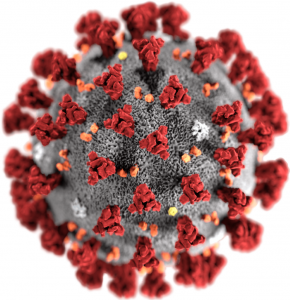
Staring in 2020, the evolution of SARS-CoV-2 variants has been an example of rapid evolution (with disastrous effects for human beings). The term variant comes from the word vary: it means “different type.” Every time someone is infected with SARS, random mutations in SARS-CoV-2’s genes cause new variants to emerge. Most of those variants, however, result in viruses that don’t work well at infecting cells and moving from one person to the next. However, from time to time, a variant arises that’s more successful than its ancestors at moving from person to person, infecting cells, and replicating while evading the human immune system were naturally selected. Through natural selection by the environment, that new variant starts to spread. In this case, the environment is us: human behavior and human biology).
For example, the graph below shows the rise of the Delta Variant in England between mid-April and mid-June of 2021. The Delta variant is a descendant (with modification) of previous strains.

Starting at the end of 2021, the omicron variant performed the same feat, quickly becoming the dominant strain of the virus in the United States (and the entire world).

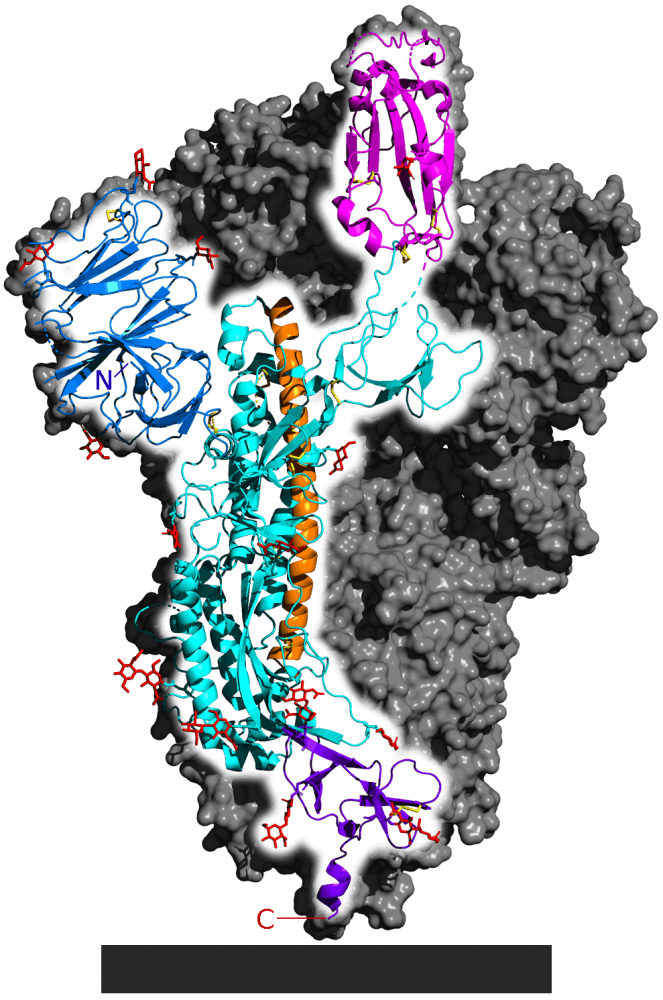
Each variant has had genotypic and phenotypic differences from its ancestors.
- Genotypic changes involve changes in the genes. In the case of organisms, that involves mutations in the DNA. In the case of a virus, that can involve changes in DNA or RNA.
- Phenotypic changes are changes in observable characteristics.
In the case of the Delta variant, a mutation in RNA (a genotypic difference) altered a single amino acid in the SARS-CoV-2’s spike protein. That change is a phenotypic difference. This change made it much easier for this variant to enter cells.
The Omicron variant has a distinctive combination of more than 50 mutations. These mutations made that variant far more transmissible. Thankfully, it also seemed to make the disease associated with an Omicron infection less severe than infection with other strains.
The takeaway: the spread of COVID-19 variants is a clear case of descent with modification. It’s an example of evolutionary change that occurred, in some cases, in a matter of months.
If you want to learn more about SARS-CoV-2 and COVID-19, you can do so in this tutorial on Learn-Biology.com.
3. The Peppered Moth
We’ve previously discussed the peppered moth in a tutorial in our population genetics unit. The peppered moth (Biston betularia) inhabits the forests of Northern England. It exists in two forms: a light colored form with black specks (that’s the peppered form), and a much darker form.
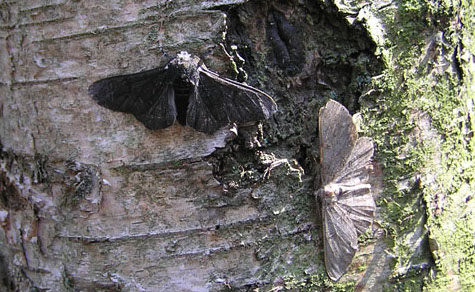
Until the mid-1800s, dark moths were rare (2% of the population), with 98% of the moths having the typical light-colored (peppered) form. This color distribution was related to camouflage, a defense that involves blending in with the environment. In this case, the function of the camouflage was to hide the moths from moth-eating birds. The peppered moth, when it’s not flying, rests on the trunks of trees. Until the mid-1800, the trees were covered with whitish growths called lichens. Look at the photograph above to see what a light and dark-colored moth looks like on a light-colored tree. If you were a bird, which color moth would be easier for you to find?
This situation — light colored moths frequent, dark colored moths rare — persisted until the mid-1800s, when there started to pollution — smoke and soot— from factories. The smoke and soot killed the lichens and covered the tree trunks. This changed the environment so that light colored camouflage became a disadvantage. Light colored moths became easy for moth-eating birds to find.
As the light colored moths were eaten, the dark colored moths survived, bred, and reproduced. By 1895, 95% of the moths were dark colored.
The images and graph below tells the story in a very compact form. Please study it for a moment.
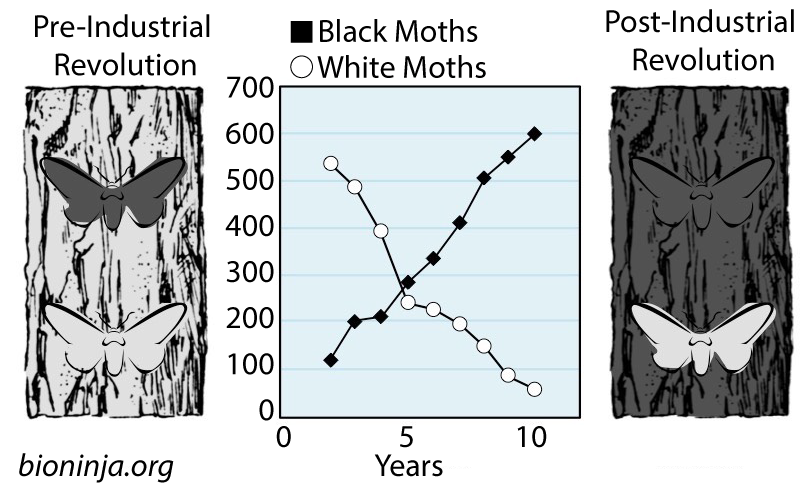
In the 1960s, pollution controls were instituted throughout Northern England (and much of the rest of the world). As a result, industrial pollution was reduced. In that new environment, the lichens came back, and the tree trunks changed in color from dark to light. As a result, light colored moths once again had the advantage,. Now, the most common phenotype is light and dark moths are rare.
If you want to watch my music video explaining the evolution of the peppered moth, you can do so here (the link opens a new tab).
Study the flashcards below before continuing.
4. Flashcards: Observing Descent with Modification
[qdeck qrecord_id=”sciencemusicvideosMeister1961-Observing Descent with Modification (HS)”]
[h]Observing Descent with Modification: Flashcards
[q]What was Darwin’s three word phrase for describing evolutionary change?
[a]Darwin’s three word phrase for describing evolutionary change was descent with modification.
[q]A change in genes is a change in ____________. A change in observable traits is a change in _____________.
[a]A change in genes is a change in genotype. A change in observable traits is a change in phenotype.
[q]What was Darwin’s idea about the pace of evolutionary change.
[a]Darwin believed that evolutionary change would be slow, taking thousands or millions of years.
[q]How have changes in SARS-CoV-2 variants involved both genotype and phenotype?
[a]When SARS-CoV-2 infects someone and replicates, mutations occur. These mutations are genetic modifications, or changes in genotype. These genetic changes can cause modifications in the virus’s phenotype, particularly in its spike protein.
[q]How has the spread of SARS-CoV-2 variants been an example of descent with modification?
[a]Each new variant is a modified descendant of a previous strain. If these modifications make the new variant better at infecting people and spreading throughout populations, then it becomes the most common variant.
[q]The red area in the graph below shows that the…
[a]The red area in the graph on the other side says that the omicron variant has become the most frequent variant.
[q]Each new SARS-CoV-2 variant started with a ______________ which was subsequently selected by the environment. In this case the environment involved human ________________ and human _______________.
[a]Each new SARS-CoV-2 variant started with a mutation which was subsequently selected by the environment. In this case the environment involved human biology and human behavior.
[q]The image below shows how well the peppered moth is ________________ when it rests on trees covered with ____________.
[a]The image below shows how well the peppered moth is camouflaged when it rests on trees covered with lichens.
[q]Explain how the change in color in the peppered moth is an example of descent with modification.
[a]Before the industrial revolution, most peppered moths were white. That’s because this color camouflaged them, enabling them to hide from predatory birds. When industrial pollution darkened the tree trunks, the dark-colored moths were better camouflaged. As a result, over a few decades, the peppered moth population’s average color shifted from light-colored to dark-colored. The new (dark-colored) population was a descendant of the ancestral light-colored population but modified by the environment for better camouflage.
[/qdeck]
5. Evolution of Antibiotic-resistant bacteria and the rise of MRSA

Another example of evolution that’s been observed in recent times has been the emergence of bacterial strains that are resistant to antibiotics.
Antibiotics are drugs that kill bacteria. Antibiotic-resistant bacterial strains have evolved ways to not be killed by antibiotics. That makes infections with these bacterial strains very dangerous.
Antibiotics were first widely used in the 1940s. One of the first antibiotics is called Penicillin. One of the targets of penicillin was a bacteria called Staphylococcus aureus (often called “Staph aureus” or S. aureus). Normally, S. aureus (along with many other types of bacteria, lives harmlessly on our skin and other parts of our bodies. But there are also forms of S. aureus that can cause skin and sinus infections, along with food poisoning, pneumonia, and wound infections.
When penicillin was first used, it was highly effective at curing infections. By 1950, only seven years after penicillin was introduced, 40% of S. aureus studied were penicillin-resistant. By 1960, this had risen to 80%. Now it’s about 98%.
What happened? It’s all about natural selection. Here’s an infographic that illustrates the process.

- Image “A shows the initial population. Most bacterial cells (the gray ones) are killed by the antibiotic. But S. aureus populations have genetic variation, and a few cells (shown in red) aren’t killed as quickly as others when exposed to the antibiotic.
- Application of the antibiotic kills the bacteria that are most easily killed, leaving only those that are resistant.
- When these resistant bacteria reproduce, their descendants will inherit their genes for antibiotic resistance. Repeat this for a few generations, and the resulting population will be mostly composed of antibiotic-resistant cells.
The widespread use of antibiotics in agriculture has made the problem worse.

In agriculture, antibiotics are used to prevent outbreaks of infection in animals that are kept in close confinement. In 2013, the US Department of Agriculture estimated that 32 million pounds of antibiotics were used in food animal production. That amounts to 80% of the antibiotics used in the United States.
As with humans, the antibiotics fed to animals (A) kill most of the bacteria, but not all of them. The ones that aren’t killed are the ones that have resistance to the antibiotics. Over time, this leads to selection for antibiotic-resistant strains (B and C). These can be transferred to people through animal products, through agricultural produce that’s been in contact with animal feces-contaminated soil or water, or during food preparation.
Methicillin is an antibiotic that was introduced in 1959. Within two years of its introduction, methicillin-resistant bacteria had been observed. These methicillin-resistant bacteria have come to be known by the acronym MRSA (methicillin-resistant S.aureus), and they’re much more dangerous than non-MRSA S. aureus. Sometimes, MRSA infections can be controlled by other antibiotics. But the concern is that our arsenal of effective antibiotics is growing increasingly thin, as the bacteria mutate around whatever selective pressure our use of antibiotics creates.
Is this evidence for evolution? Absolutely. With the rise of antibiotic-resistant bacteria, we have a clear example of descent with modification. In this case, the phenotype is resistance to the antibiotic. The genotype is selection for genes that produce antibiotic resistance.
Study the flashcards below before continuing.
6. Flashcards: Antibiotic Resistance
[qdeck qrecord_id=”sciencemusicvideosMeister1961-Antibiotic Resistance (HS)”]
[h]Antibiotic resistance
[i]Biohaiku
Antibiotics
At first a miracle drug
Now, much less useful!
[q]A medicine that destroys harmful bacteria is an
[a]antibiotic
[q]Bacteria that are not killed or inhibited by antibiotics are said to be
[a]Bacteria that are not killed or inhibited by antibiotics are said to be antibiotic resistant
[q]Use the image below to tell the story of how antibiotic resistance can evolve.
[a]”A” shows a bacterial population with variation. “B” shows how most of the bacteria will be killed by the antibiotic, but some — the ones with genes for antibiotic resistance — will survive. “C” shows how when antibiotic-resistant bacteria reproduce, they’ll pass on their genes to their descendants. As a result, the new population (the descendants) will mostly be antibiotic-resistant.
[q]A big cause of the rise of antibiotic resistance (illustrated below) has been the overuse of antibiotics in ____________
[a]A big cause of the rise of antibiotic resistance (illustrated below) has been the overuse of antibiotics in agriculture.
[q]A strain of S.aureus that is of particular concern is
[a]A strain of S. aureus that is of particular concern is MRSA.
[q]Descent with modification involves changes in phenotype and genotype. What are the genotypes and phenotypes involved in the evolution of antibiotic-resistant bacteria?
[a]The phenotype is the resistance of features (mostly biochemical) that provide resistance to antibiotics. The genotype involves the genes that code for these features.
[/qdeck]
7. Evolution of Pesticide Resistance in Mosquitoes
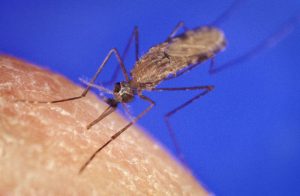
Malaria is a tropical disease caused by a parasite that infects a person’s red blood cells. Malaria is the number 1 killer of children worldwide. The disease is particularly prevalent in sub-Saharan Africa (source: Forgotten Children Worldwide)
Mosquitoes are the primary way that the parasite that causes malaria spreads.
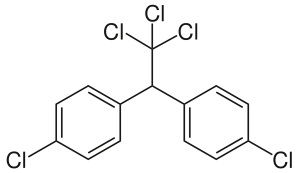
One approach to controlling malaria has been to suppress mosquito populations with insecticides (insect-killing chemicals). One such pesticide is DDT.
Based on the story of antibiotic resistance in bacteria, you should be able to predict what happened when DDT started to be used to control the mosquitoes that spread malaria.
Here’s a graph showing what happened when scientists studied the resistance of mosquitoes to exposure of a DDT solution for one hour, every day, for a period of 18 months.
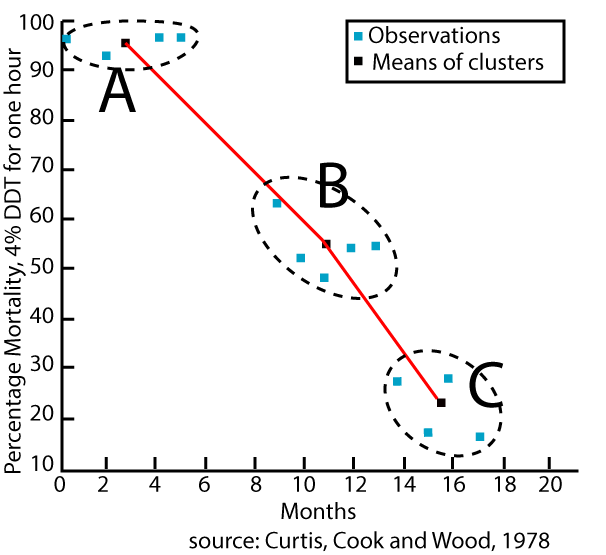 The X-axis on the graph shows time. The Y axis shows the percentage of mortality. Mortality is the number of death in a given period of time. For example, the mortality at point A is over 90%. That means that 90% of the mosquitoes were killed after one hour of exposure to the test solution (4% DDT).
The X-axis on the graph shows time. The Y axis shows the percentage of mortality. Mortality is the number of death in a given period of time. For example, the mortality at point A is over 90%. That means that 90% of the mosquitoes were killed after one hour of exposure to the test solution (4% DDT).
Note how different the mortality rate is at point B (10 months) and point C (16 months)
Based on what we learned about bacterial resistance to antibiotics, you can probably explain what’s happening. Study the graph and answer the questions that follow.
[qwiz qrecord_id=”sciencemusicvideosMeister1961-DDT Resistance Interactive Reading (HS)”]
[h] DDT Resistance In Mosquitoes
[q] At which time period (A, B, or C) did the vast majority of the mosquitoes have pesticide resistance?
[textentry single_char=”true”]
[c]IE M=[Qq]
[f]IEV4Y2VsbGVudC4gQXQgcG9pbnQgJiM4MjIwO0MsJiM4MjIxOyBvbmx5IGFib3V0IDIwJSBvZiB0aGUgbW9zcXVpdG9lcyBhcmUgZHlpbmcgYWZ0ZXIgMSBob3VyIG9mIGV4cG9zdXJlIHRvIHRoZSBzb2x1dGlvbi4gSWYgdGhleSYjODIxNztyZSBub3QgZHlpbmcsIHRoZXkgbXVzdCBiZSByZXNpc3RhbnQu[Qq]
[c]IEVudGVyIHdvcmQ=[Qq]
[f]IFNvcnJ5LCB0aGF0JiM4MjE3O3Mgbm90IGNvcnJlY3Qu[Qq]
[c]ICo=[Qq]
[f]IE5vLiBGaW5kIHRoZSBwb2ludCBpbiB0aW1lIHdoZW4gdGhlIG1vcnRhbGl0eSAodGhlIGFtb3VudCBvZiBkZWF0aCkgaXMgdmVyeSBsb3cuIFRoYXQmIzgyMTc7cyB3aGVuIG1vc3Qgb2YgdGhlIHBvcHVsYXRpb24gaXMgcmVzaXN0YW50Lg==[Qq]
[q] At which time period (A, B, or C) were the majority of the mosquitoes killed by DDT?
[textentry single_char=”true”]
[c]IE E=[Qq]
[f]IEV4Y2VsbGVudC4gQXQgcG9pbnQgJiM4MjIwO0EsJiM4MjIxOyB0aGUgbW9ydGFsaXR5IGlzIGFsbW9zdCAxMDAlLiBUaGF0IG1lYW5zIHRoYXQgYXQgdGhpcyBwb2ludCBpbiB0aW1lLCB0aGUgbW9zcXVpdG9lcyBhcmUgc3VzY2VwdGlibGUgdG8gRERULg==[Qq]
[c]IEVudGVyIHdvcmQ=[Qq]
[f]IE5vLCB0aGF0JiM4MjE3O3Mgbm90IGNvcnJlY3Qu[Qq]
[c]ICo=[Qq]
[f]IE5vLiBGaW5kIHRoZSBwb2ludCBpbiB0aW1lIHdoZW4gdGhlIG1vcnRhbGl0eSAodGhlIGFtb3VudCBvZiBkZWF0aCkgaXMgdmVyeSBoaWdoLiBUaGF0JiM4MjE3O3Mgd2hlbiBtb3N0IG9mIHRoZSBwb3B1bGF0aW9uIGlzIHN0aWxsIGJlaW5nIGtpbGxlZCBieSBERFQu[Qq]
[q] At point “C” in the graph below, most of the mosquitoes were [hangman] to DDT.
[c]IHJlc2lzdGFudA==[Qq]
[f]IEdvb2Qh[Qq]
[/qwiz]
8. Conclusion and Cumulative Quiz: Historical Examples of Evolution
In what’s above, you learned about four examples of descent with modification — evolution — that have been observed in recent times.
- Changes in SARS-CoV-2
- The peppered moth
- Antibiotic resistance in bacteria
- Pesticide resistance in mosquitoes.
Note that rapid evolution has been widely observed in other viruses, insects, bacteria and other organisms. That’s partly because all of these reproduce rapidly. Many generations occur in a short span of time, allowing for observable change in the course of months or years. But even some slow reproducers seem to evolve rapidly. In recent years, in response to natural selection by poachers who kill elephants for their tusks, some populations of elephants have evolved forms without tusks. Click to read more about that in this article at NPR.
If you want to delve deeper, use the following links
- This article in Discover Magazine has several additional examples of recently observed evolutionary change (the link, and those below, open in a new browser tab).
- Research relating to the evolution of the Peppered Moth (described above) has been widely attacked by Creationists (people who attack evolution because they believe that it contradicts the creation story in the Bible). However, the initial work on the peppered moth (done by B.D. Kettlewell in the 1950s) was validated by experiments at the start of the 21st century by Michael Majerus. You can read about the evolution of the peppered moth on Wikipedia
- In the case of the apple maggot fly, relatively recent change is leading to species formation.
Note that because these have occurred in such a short period of time, the changes that have resulted might not seem dramatic. It’s not like seeing a species like Pakicetus (an ancient ancestor of whales) transform from a land-living mammal into a Basilosaurus (an ancient whale ) into a modern humpback whale.
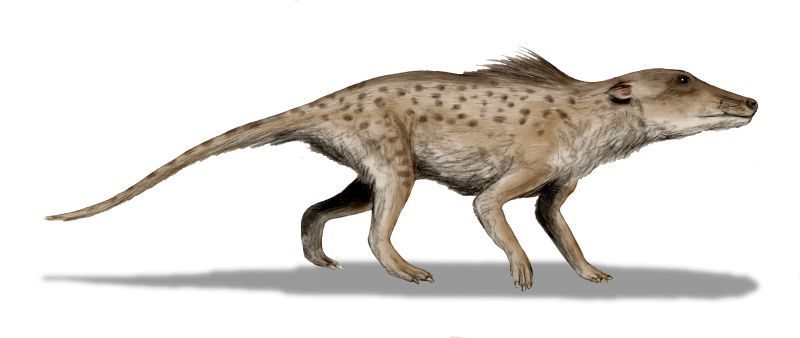 |
 |
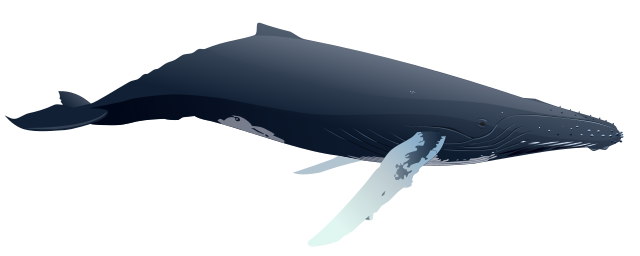 |
| Pakicetus (about 50 million years ago). 1 – 2 meters long. | Basilosaurus (41 to 34 million years ago). About 16 meters long. | Humpback whale (current). 12 – 16 meters long. |
This kind of change does take millions of millions of years. You’ll see how there’s evidence for these changes, and how they serve as evidence for evolution in the next tutorials. But first, please complete the quiz below.
[qwiz qrecord_id=”sciencemusicvideosMeister1961-Historical Examples of Evolution (HS)”]
[h] Historical Examples of Evolutionary Change
[i]
[q] Because of the large body of evidence supporting evolution, evolution should be thought of as a [hangman], rather than a [hangman].
[c]IHRoZW9yeQ==[Qq]
[f]IEdyZWF0IQ==[Qq]
[c]IGh5cG90aGVzaXM=[Qq]
[f]IEdyZWF0IQ==[Qq]
[q] If evolution is true, then one should be able to provide evidence for descent with [hangman] in any specific lineage.
[c]IG1vZGlmaWNhdGlvbg==[Qq]
[f]IEdyZWF0IQ==[Qq]
[q] Darwin thought that evolutionary change had to happen slowly. However, observations of evolutionary change in the 19th, 20th, and 21st centuries indicate that evolutionary change can happen [hangman]
[c]IHJhcGlkbHk=[Qq]
[f]IEdyZWF0IQ==[Qq]
[q]The evolution of SARS-CoV-2 [hangman] is an example of how in a rapidly reproducing system like a virus, evolution can happen in months.
[c]dmFyaWFudHM=[Qq]
[q]Each new SARS-CoV-2 variant began with a [hangman] that was subsequently selected for by the environment (which included human biology and human behavior)
[c]bXV0YXRpb24=[Qq]
[q multiple_choice=”true”]The evolution of the peppered moth during the past 150 years has involved selection by predatory birds for
[c]ZmxpZ2h0IHNwZWVk[Qq]
[f]Tm8uIExvb2sgYXQgdGhlIHBob3RvIGJlbG93LiBUaGlzIGlzIGFuIGFkYXB0YXRpb24gZm9yIF9fX19fX19fX18uIEhpbnQ6IGl0IGJlZ2lucyB3aXRoIGEgJiM4MjIwO2MuJiM4MjIxOw==
Cg==[Qq]
[c]Y2Ftb3Vm bGFnZQ==[Qq]
[f]RXhjZWxsZW50ISBBc8KgIHlvdSBjYW4gc2VlIGJlbG93LCB0aGUgcGVwcGVyZWQgbW90aCBpcyBiZWF1dGlmdWxseSBjYW1vdWZsYWdlZCBhZ2FpbnN0IHRoZSBsaWNoZW5zIGluIGl0cyBlbnZpcm9ubWVudC4gQnV0IHRoYXQgd291bGRuJiM4MjE3O3QgYmUgdGhlIGNhc2UgaWYgdGhlIGxpY2hlbnMgYWxsIGRpZWQu
Cg==[Qq]
[c]YmFkIHRhc3Rl[Qq]
[f]Tm8uIExvb2sgYXQgdGhlIHBob3RvIGJlbG93LiBUaGlzIGlzIGFuIGFkYXB0YXRpb24gZm9yIF9fX19fX19fX18uIEhpbnQ6IGl0IGJlZ2lucyB3aXRoIGEgJiM4MjIwO2MuJiM4MjIxOw==
Cg==[Qq]
[q] Because of our overuse of antibiotics, many bacterial strains have evolved to become antibiotic [hangman].
[c]IHJlc2lzdGFudA==[Qq]
[f]IEdyZWF0IQ==[Qq]
[q] The difficult-to-treat strain of Staphylococcus aureus bacteria that has evolved in recent decades is known by the acronym [hangman].
[c]IE1SU0E=[Qq]
[f]IEdyZWF0IQ==[Qq]
[q]As the image below shows, the problem of antibiotic resistance has been made much worse by the overuse of antibiotics in [hangman].
[c]YWdyaWN1bHR1cmU=[Qq]
[q]Since its introduction in the 1940s, DDT has become increasingly ineffective due to the evolution of pesticide [hangman] in mosquitoes that carry the parasite which causes [hangman].
[c]cmVzaXN0YW5jZQ==[Qq]
[c]bWFsYXJpYQ==[Qq]
[/qwiz]
Links
- Homologous and Vestigial Structures (the next tutorial in this module)
- Evidence for Evolution (HS Level) Menu
